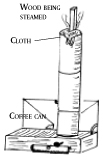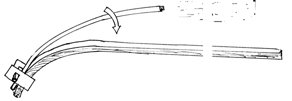Alaska Science Camps, Fairs & Experiments
ANKN is a resource for compiling and exchanging information
related to Alaska Native knowledge systems and ways of knowing. We
are pleased to create and distribute a variety of publications
that assist Native people, government agencies,
educators and the general public in gaining access to the knowledge
base that Alaska Natives have acquired through cumulative experience
over millennia.
TO ORDER THIS PUBLICATION:
Contact the ANKN
offices at 907-474-1902 or email uaf-cxcs@alaska.edu. Steaming
    
For untold centuries oldtimers have been
bending natural materials. Some materials bend more easily than
others. We have always been looking for ways to improve the bending
of natural materials.
The most common traditional applications of bending are: Aleut
bentwood hats, snowshoes, drum frames, canoe ribs and sled parts.
When we bend materials, there are two stresses.
- The inside of the bend is being compressed.
- The outside of the bend is being stretched.

Obviously, the thinner the material is, the easier it is to bend
as the inside is compressed less and the outside stretched less.
Oldtimers spent much time looking for the choice piece of wood
that would not break when it was bent.
Steaming
When wood is dry it isn't very flexible. Wetting the wood helps
the bending process. Steaming helps even more. However, there are
advantages and disadvantages of each. Excessive steaming weakens the
wood.
Many people wrap the wood with a hot steamy towel as it comes out
of the steamer. This keeps it from drying and cooling until bending
is complete.

It is important to bend the wood gently, flexing it gradually,
being careful not to bend too much in one place. If there is a spot
that doesn't want to bend, we put it over our knee at that place and
gently flex it. If it still doesn't bend, we take a timeout, and thin
it at that spot with a hand plane or knife.
WRAPPING TO PREVENT SPLITTING

If the fibers start to split off, quickly wrap that place with
string, keeping the fibers intact. Continue bending gently.
 Cut
or split identical pieces of green wood about two feet long. Identify
which side is from the outside of the tree and which side from the
inside. Try bending two ways: inside of tree on the outside of the
bend, and outside of the tree on the outside of the bend. Which way
seems to bend the easiest? Which way breaks more easily than the
other. Cut
or split identical pieces of green wood about two feet long. Identify
which side is from the outside of the tree and which side from the
inside. Try bending two ways: inside of tree on the outside of the
bend, and outside of the tree on the outside of the bend. Which way
seems to bend the easiest? Which way breaks more easily than the
other.
EXPERIMENT: EASE OF
BENDING
|
Cut or split identical pieces of green wood. Try to bend the first
piece. Try to bend a second piece after it has been soaked in cold
water for a time. Try a third piece after it has been soaked in hot
water, and a fourth piece after it has been steamed. What differences
do you notice?
You can make a steamer like either of the ones illustrated
here.

 Be
careful, as steam and hot water can inflict severe burns. Use gloves
and eye protection. Some people say the steamer needs to have a great
deal of water, and to use a drum. Be
careful, as steam and hot water can inflict severe burns. Use gloves
and eye protection. Some people say the steamer needs to have a great
deal of water, and to use a drum.
Try bending different materials, birch, spruce, willows, and other
natural materials after they have been steamed or soaked in hot
water. Many people have spent hours shaping a piece of wood, only to
have it crack before taking shape. Learn how to steam on scraps
first. Then steam and bend carved pieces.
Traditional steaming
In parts of Alaska, steaming was done by digging a pit, and making
a fire in the pit. The ashes were scraped from the hole. The wood was
wrapped in seaweed or wet grass. The wood was placed in the hole and
buried with hot dirt and topped with hot coals, the moisture from the
seaweed was heated by the dirt and coals, and the wood rendered soft
and pliable.
EXPERIMENT: WEAKENED BY
STEAMING?
|
 Cut
or split two identical pieces of wood. Soak one in very warm water,
bend it, and let it dry. Steam the other piece for quite a while, and
bend it and let it dry. Test both pieces. Is the piece that was
steamed for a long time weaker or stronger than the piece that was
only soaked in warm water? Cut
or split two identical pieces of wood. Soak one in very warm water,
bend it, and let it dry. Steam the other piece for quite a while, and
bend it and let it dry. Test both pieces. Is the piece that was
steamed for a long time weaker or stronger than the piece that was
only soaked in warm water?
Since it is impossible to find two pieces of wood that are
identical, it might be best to try to bend four pieces, two in warm
water and two steamed.
Bending Jig
When wood is bent, we often need a form or shape to bend the wood
upon. Many such forms, or jigs are possible. Below is a jig to bend
sled runners. The runners are clamped to the jig until they dry. Slow
careful drying prevents cracking.
Snowshoes are bent around a jig that shapes them to the proper
size and form.

Aleut bentwood hats are often bent around a frame, and then the
pieces are held together with clamps. The wood is soaked in a wide
pan of hot water, not steamed.
Drum makers often cut very thin strips of wood, steam them, then
bend them around a circular jig, gluing the different layers together
into a very strong round frame.
BENDING A DRUM FRAME IN THIN STRIPS
THAT ARE GLUED TOGETHER.

|